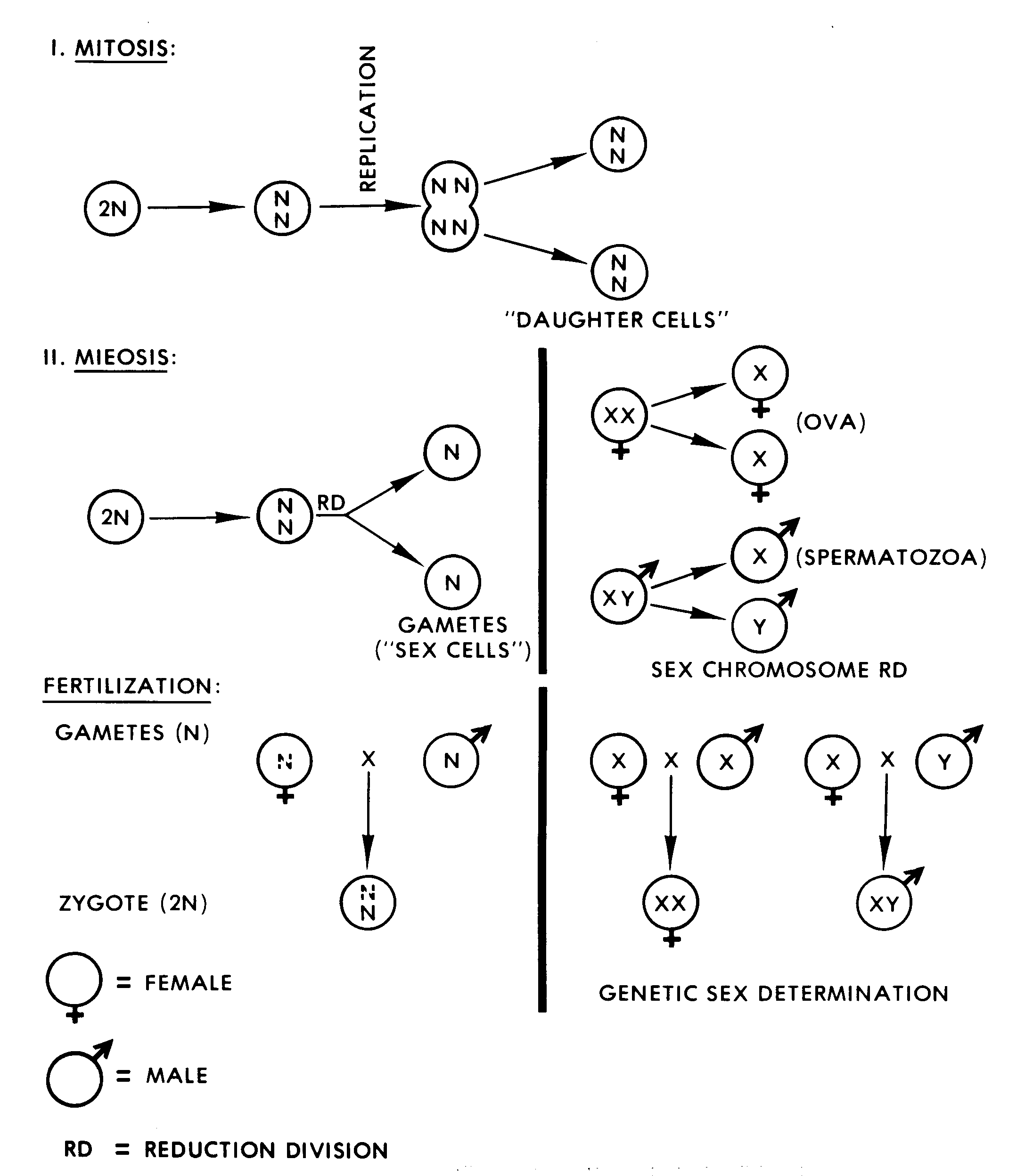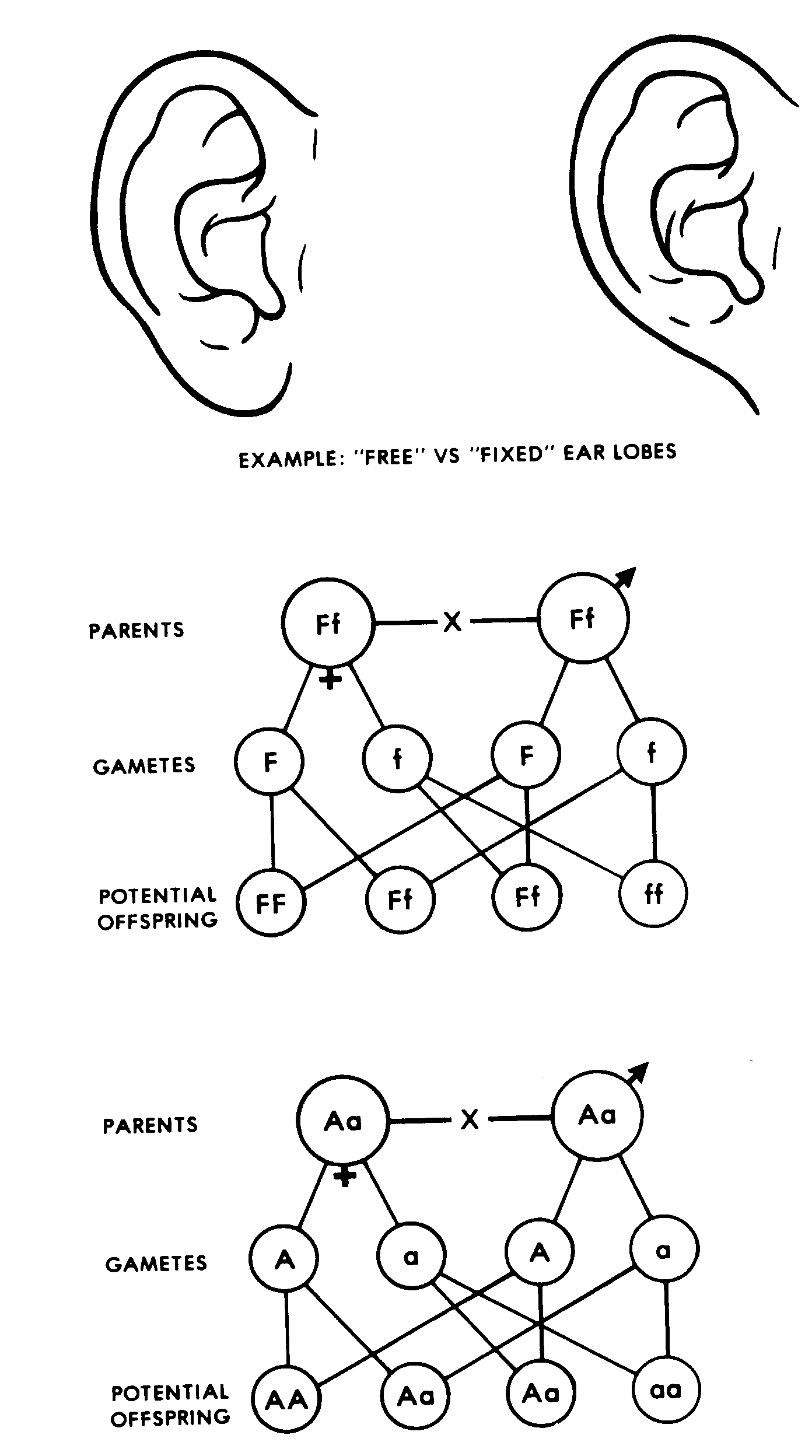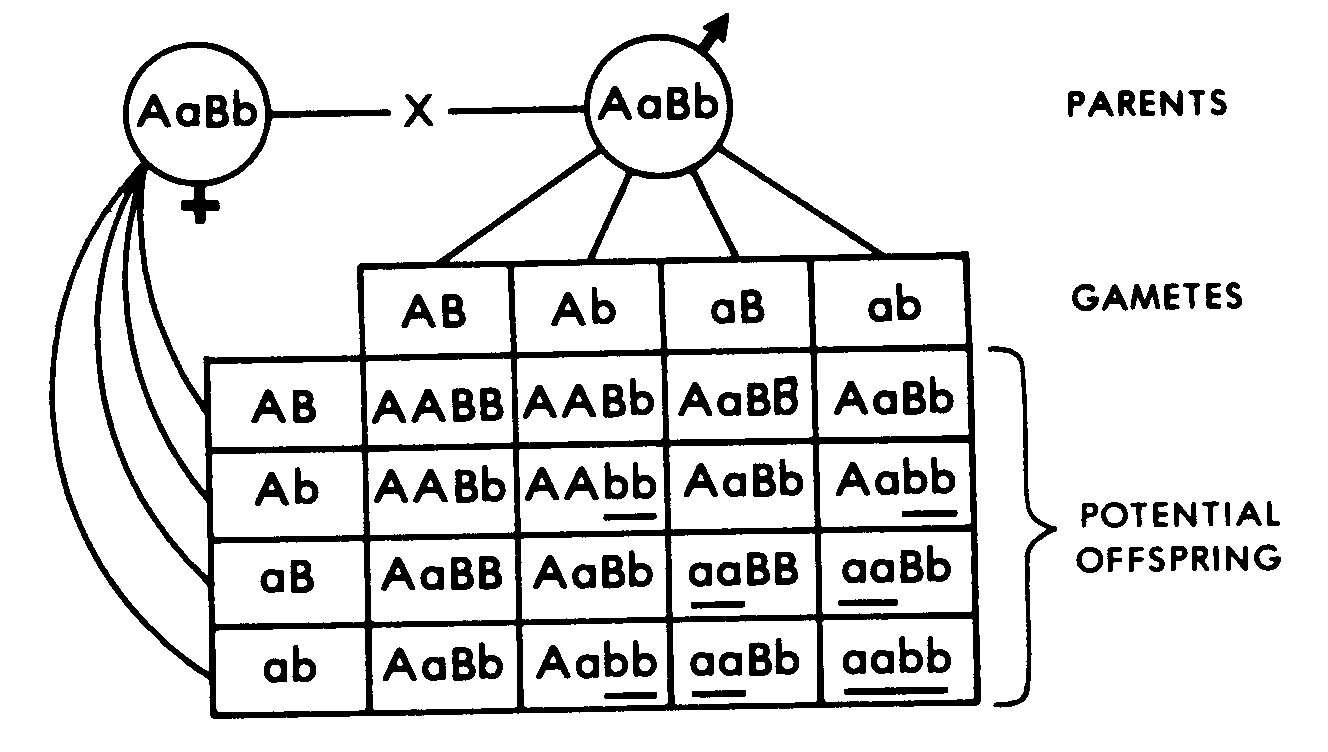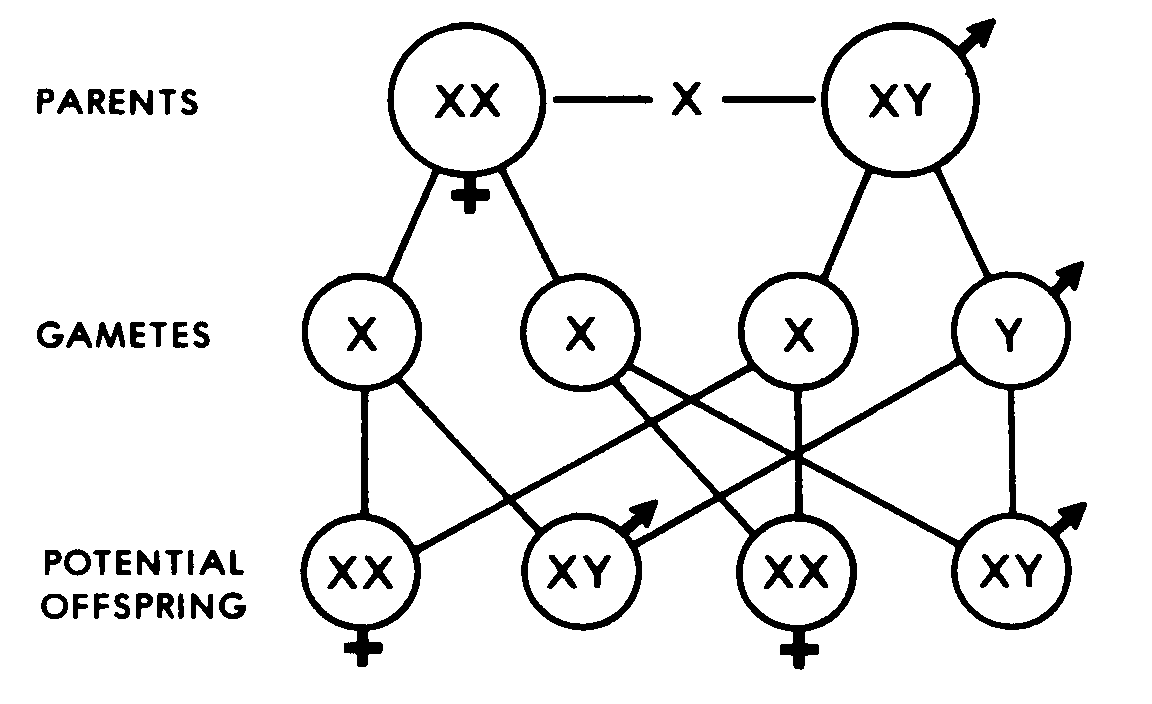
LESSON ASSIGNMENT
LESSON 14 Some Elementary Human Genetics.
LESSON ASSIGNMENT Paragraphs 14-1 through 14-10.
LESSON OBJECTIVES After completing this lesson, you should be able to:
14-1. Given a list of statements about elementary human genetics, select the false statement.
14-2. Identify diploid (2N=46) and haploid (N=23) conditions as related to ordinary body cells, mitotic daughter cells, gametes, and zygotes.
14-3. Match important genetic terms with their definitions.
SUGGESTION After completing the assignment, complete the exercises at the end of this lesson. These exercises will help you to achieve the lesson objectives.
LESSON 14
SOME ELEMENTARY HUMAN GENETICS
14-1. INTRODUCTION
a. Heredity. With respect to both anatomy and physiology, offspring tend to resemble their parents. This is due to the process known as heredity or inheritance. Heredity depends upon the passage of materials called genes from one generation to the next. Due to genes, all human beings resemble each other in general, but with individual differences.
b. Genetic Control. The genes control the life processes of each body cell. In an individual, each cell has identical genes. Overall, genes determine the range of potentiality of an individual, and the environment develops it. For example, good nutrition will help a person to attain his full body height and weight within the limits determined by his genes.
14-2. HISTORY OF GENETICS
a. Over a hundred years ago, the Austrian monk Gregor Mendel began the science of genetics by experimenting with successive generations of peas. He originated the concepts of genes, dominance, and recessiveness. By choosing the simplest and most straightforward situations, he set forth the basic principles of inheritance. However, his work was not well known for many years.
b. With the turn of the century, the principles of genetics were "rediscovered," particularly by the Dutch biologist Hugo de Vries. In the following years, the principles of genetics were further developed by the American, T. H. Morgan.
c. In 1944, Oswald T. Avery and his colleagues used bacterial studies to prove that DNA was the genetic substance of chromosomes.
d. In 1954, Watson and Crick published the double helix model of DNA. (A helix is a spiral form.)
e. Three Frenchmen, Jacob, Lwoff, and Monod, discovered how information is transmitted from the genes to the sites of protein synthesis. This led to the "cracking" of the genetic code, used to translate DNA patterns for the production of specific proteins.
14-3. THE GENE
DNA (deoxyribonucleic acid) is a large molecule consisting of two strands in a double-helix arrangement. Along each strand are specific chemical elements called nucleotides. Each gene consists of a portion of a strand, including a number of nucleotides. Through the arrangement of its nucleotides, the gene provides coded information for the construction of proteins. After these proteins are assembled elsewhere in the cell, they serve as building blocks for the cell and as enzymes to promote the life processes of the cell.
14-4. CHROMOSOMES
a. A chromosome is a very long double-helix thread of DNA. Thus, each chromosome consists of a large number of genes. The genes have very specific locations along the length of each chromosome. Recently, researchers have been able to identify specific sequences of genes along a chromosome and illustrate the sequences with gene maps.
b. Except during cell division, chromosomes are observed as granules of chromatin material within the cell nucleus. During the process of cell division, this chromatin material aggregates so that it may be identified as one of the 46 individual chromosomes found in each human cell (diploid condition).
c. These 46 chromosomes of the human cell occur in pairs. Thus, we may say that there are two sets, with 23 chromosomes in each set.
(22 + 1) X 2 = 46
Of the 23 different chromosomes, 22 deal with the body in general and are called autosomal chromosomes. The last chromosome is called the sex chromosome. There are two kinds of sex chromosomes--X and Y. When an individual's cells each have two X chromosomes (XX), the individual is genetically a female. On the other hand, when an individual's cells each have one X and one Y chromosome (XY), that individual is genetically a male.
14-5. CELL DIVISIONS
The two types of cell division are illustrated in figure 14-1.
a. Mitosis. New cells must be produced for replacement of worn-out cells and for growth and development of the individual. For these purposes, the existing cells undergo cell division and produce new cells. The usual process of cell division is called mitosis. In mitosis, the two daughter cells produced by the original cell have essentially the same genetic material as the original cell.
b. Meiosis. Meiosis is a type of cell division which occurs only in the gonads. It results in the formation of the gametes, or sex cells. In mitosis, the chromosomes are duplicated; in meiosis, the two sets of chromosomes separate, and one set of 23 goes to each of the gametes. Thus, meiosis involves a reduction division. The final result is that each gamete has only one set of 23 chromosomes (haploid condition).

Figure 14-1. Cell division and fertilization.
14-6. FERTILIZATION
a. To produce a new individual, the male gamete (spermatozoon) must join with the female gamete (ovum). This joining of the gametes is called fertilization. The gametes join to form a zygote. The zygote is a single cell which is the beginning of a new human being. The zygote has two sets of chromosomes (46), the appropriate number for the human species. Thus, in the process of fertilization, the human genetic makeup is reconstituted.
b. The existence of separate male and female sexes provides an important advantage. Each individual is the product of a new combination of human genetic material. Thus, there is always the potential for improvement in the human species.
14-7. TERMINOLOGY
a. Genotype/Phenotype. The genotype is the actual genetic makeup of an individual. The phenotype is the physical and functional makeup of an individual as determined both by the genotype and the environment.
b. Dominant/Recessive. Consider a gene in one set of chromo-somes and the corresponding gene in the other set. If one of the genes alone can produce a characteristic of the phenotype, the gene is said to be dominant. If both genes must be the same to produce a characteristic of the phenotype, then the genes are recessive. In a situation where one of the pair is dominant and the other is recessive, the dominant gene determines the ultimate characteristic.
c. Homozygous/Heterozygous. Again, consider a gene in one set of chromosomes and the corresponding gene in the other set. If the two genes are the same, we say that the individual is homozygous for that trait. If the two genes are different, we say that the individual is heterozygous for that trait.
d. Fraternal/Identical. In multiple births, two or more of the newborn may or may not resemble each other closely. They may resemble each other in sex (gender) and other physical and functional traits.
(1) If two of the individuals are different, they are called fraternal twins.
(2) If they closely resemble each other, they are called identical twins. Identical twins are believed to originate in a common zygote, which separates into two entities at a very early stage. Thus, identical twins have the same genetic makeup. However, one is often right-oriented and the other left-oriented.
14-8. SOME SIMPLE GENETIC COMBINATIONS (CROSSINGS)
a. The Monohybrid Crossing (Figure 14-2). Again, consider a gene in one set of chromosomes and the corresponding gene in the other set. This involves two genes of a single inherited element. Assume that each parent has one dominant gene (A) and one recessive gene (a), a heterozygous condition (Aa). Thus, 50% of the gametes from each parent will carry the dominant gene (A), and 50% of the gametes will carry the recessive gene (a). The potential crossings of the genes are AA, Aa, Aa, and aa.

Figure 14-2. A monohybrid crossing.
(1) If we perform many identical monohybrid crossings of this type, one-quarter of the offspring will be homozygous for the dominant gene (AA). One-half will be heterozygous (Aa), having one dominant and one recessive gene. The remaining quarter will be homozygous for the recessive gene (aa).
(2) Three-quarters of the offspring (AA or Aa) will have the phenotype trait produced by the dominant gene (A). One-quarter (aa) will show the phenotype trait produced by the recessive gene.
(3) As we have seen, the heterozygous organisms (Aa) make up 50% of the offspring. These are often called carriers. Although their phenotype does not show the recessive trait, they can still transmit that trait to their offspring.
b. The Dihybrid Crossing (Figure 14-3). Now, consider two genes in one set of chromosomes and the corresponding pair of genes in the other set. Assume that each parent is heterozygous for both genes (AaBb), where A and B are dominant and a and b are recessive. The potential gametes from each parent will then have gene pairs AB, Ab, aB, or ab.

Figure 14-3. A dihybrid crossing.
(1) If we perform many identical dihybrid crossings of this type, 14 out of 16 (7 out of 8) will have genotypes including both dominant and recessive genes. One-fourth will be AaBb. AaBB, AABb, Aabb, and aaBb will each account for one-eighth of the total offspring. AABB, AAbb, aaBB, and aabb will each account for one-sixteenth of the total offspring. Thus, one-fourth (4 out of 16) are homozygous.
(2) This example helps to illustrate the consequences of large numbers of gene pairs. Since there are many, many pairs of genes in the 46 chromosomes of humans, there will be a huge number of different offspring that are possible. Thus, except in the case of identical twins, the occurrence of genetically identical persons is virtually impossible.
NOTE: The proportions of genotypes given for these crossings are statistical estimates based on many repetitions. For any one offspring, any one of the possibilities can occur.
14-9. MODIFYING CONDITIONS
Often, there is no clear-cut dominance or recessiveness within a pair of genes. Also, most human traits are influenced by more than one pair of genes.
a. Incomplete Dominance. In incomplete dominance, the heterozygous condition (Aa) produces a phenotype partially resembling both the homozygous dominant condition (AA) and the homozygous recessive condition (aa). An example is Wolman's disease, a homozygous recessive condition leading to the accumulation of lipids in the body. Persons who are heterozygous for this trait tend to have a high level of cholesterol in their serum.
b. Complementary Inheritance. In complementary inheritance, two independent pairs of genes affect a trait. Both must be present for a trait to occur.
c. Multifactorial Inheritance. Most human characteristics are affected by a number of gene pairs.
14-10. CLINICAL IMPLICATIONS
Genes can be affected and changed by a number of circumstances. Some changes may be beneficial. Other may be harmful. In either case, the effects will be transmitted to one's offspring.
a. A gene may be lost, for example, by a gamete. The resulting off-spring may then not have a certain trait. For example, some individuals are unable to produce a specific enzyme because they do not have the appropriate gene. A metabolic process using that enzyme may be impossible for that individual.
b. Some individuals may have an excessive number of genes. Examples are individuals with an extra X or Y chromosome. This can substantially affect both anatomy and personality.
c. Genetic charts and genetic counseling are sometimes used to advise prospective parents of genetic problems they may expect with their offspring.
d. Technical advances in the biological sciences have made genetic engineering possible. Thus, we see the rise of an industry devoted to altering the genetic makeup of microorganisms for the purpose of producing certain chemicals. The chief value of many of these chemicals will be to correct deficiencies in humans, such as insulin for diabetes. (In cloning, individual cells are cultured to produce numerous organisms, all with the same genotype.)

Figure 14-4. A sex-linked monohybrid crossing.